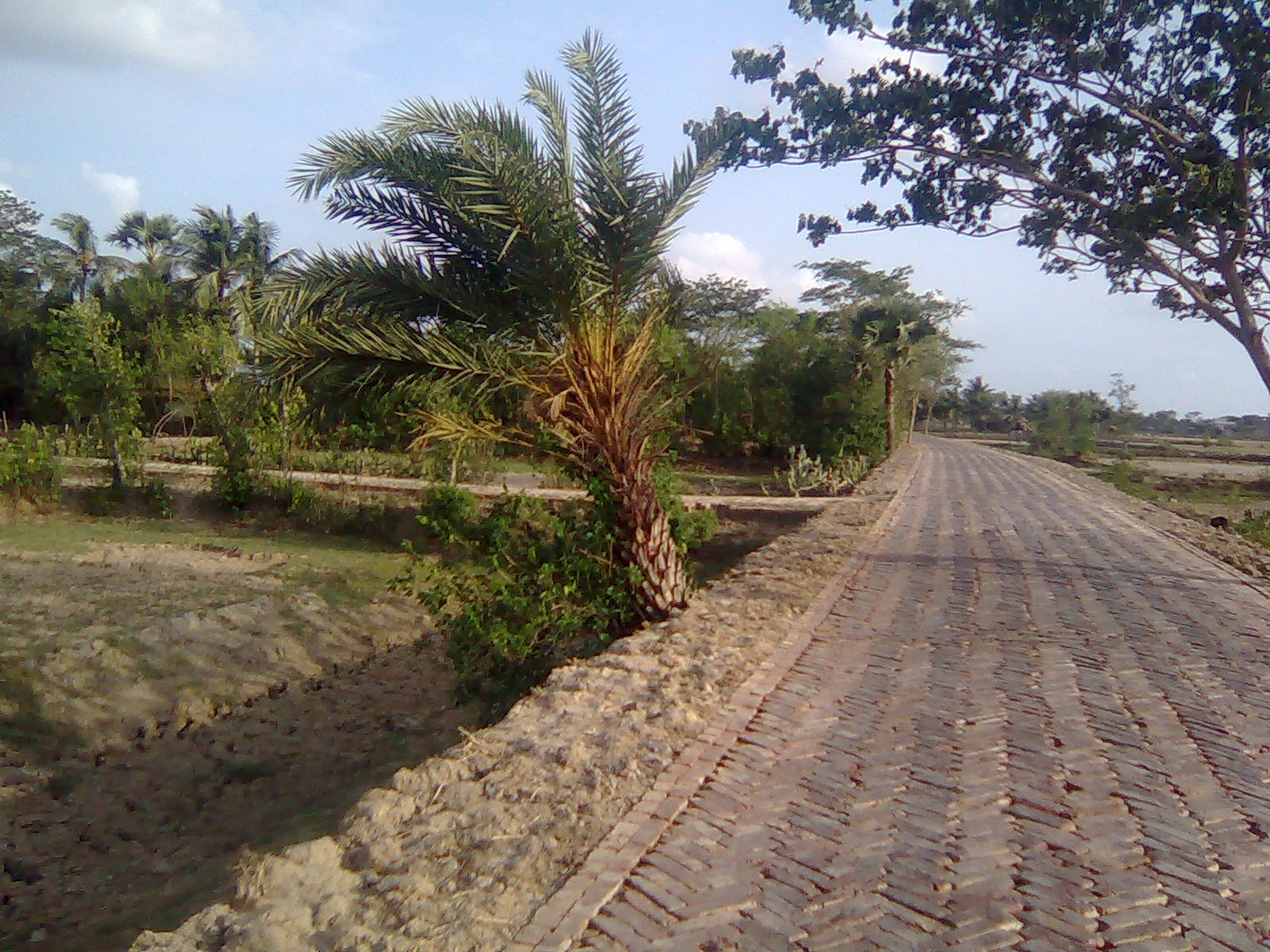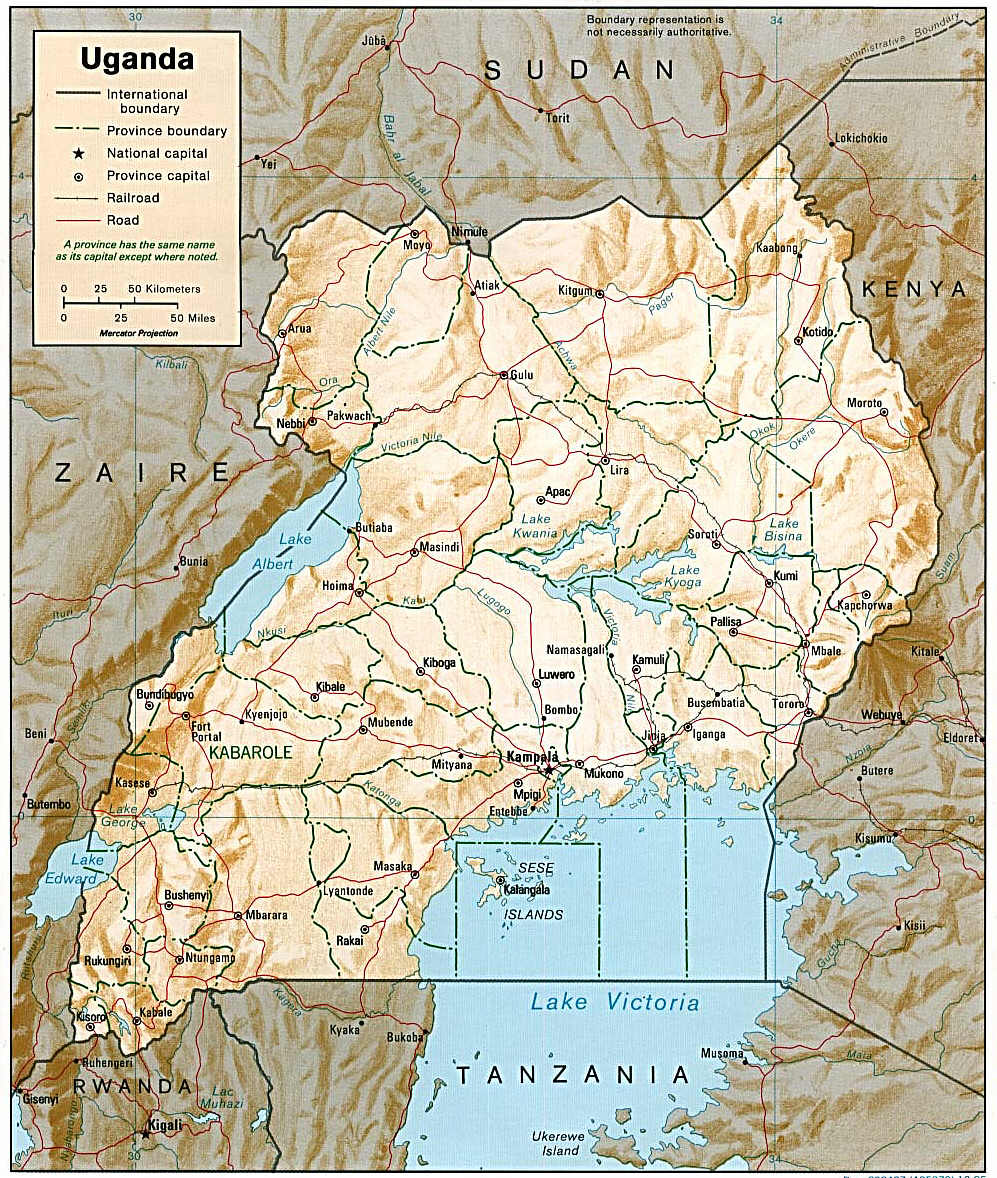|
Moroto–Nakapiripirit Road
Moroto–Nakapiripirit Road is a road in the Northern Region of Uganda. The road connects the towns of Moroto, the largest town in the Karamoja sub-region, and Nakapiripirit in the same sub-region. Location The road starts at Moroto and continues south through Lorengedwat, ending in Nakapiripirit, a distance of approximately . Nakapiripirit lies on the way to Mbale, the nearest large town, approximately south of Nakapiripirit. The coordinates of the road near Lorengedwat are 2°20'48.0"N, 34°35'27.0"E (Latitude:2.346667; Longitude:34.5908331). Upgrading to bitumen Beginning with the 2011/2012 national budget, road became one of those planned to be upgraded from gravel to bituminous surface. With political pressure from the Karamoja parliamentary caucus, the road was prioritized in the 2013/2014 financial year. On 12 November 2013, President Yoweri Museveni commissioned the start of construction. The China Road and Bridge Construction Corporation, a subsidiary of the China C ... [...More Info...] [...Related Items...] OR: [Wikipedia] [Google] [Baidu] |
Moroto Town
Moroto is a town in Moroto District in the Northern Region of Uganda. It is the location of the district headquarters. Location Moroto is approximately , by road, east of Gulu, the largest city in the Northern Region of Uganda. This is about , by road, northeast of Mbale, the largest city in the Eastern Region of Uganda. Moroto is located approximately , by road, northeast of Kampala, the capital and largest city of Uganda. The geographical coordinates of Moroto Town are 2°31'48.0"N, 34°40'12.0"E (Latitude:2.5300; Longitude:34.6700). Moroto sits at an average elevation of above mean sea level. Population The 2002 national census estimated the population of Moroto at 7,380. In 2010, the Uganda Bureau of Statistics (UBOS) estimated the population at 11,600. In 2011, UBOS estimated the mid-year population at 12,300. In 2014, the national population census put the population of Moroto at 14,196. In 2020, UBOS estimated the mid-year population of the town at 16,300 people. The ... [...More Info...] [...Related Items...] OR: [Wikipedia] [Google] [Baidu] |
Moroto District
Moroto District is a district in the Northern Region of Uganda. The town of Moroto is the site of the district headquarters. Location Moroto District is bordered by Kaabong District to the north, Kenya to the east, Amudat District to the south, Nakapiripirit District to the southwest, Napak District to the west, and Kotido District to the northwest. Moroto Town, where the district headquarters, is at the foot of Mt. Moroto. The town of Moroto is approximately , by road, northeast of Mbale, the nearest large city. This is about , by road, northeast of Kampala, the capital and largest city of Uganda. Overview Moroto District is part of the larger Karamoja sub-region. Moroto District is "characterized by rocky mountainous landscape with moderately low rainfall". It is composed of three counties: Bokora County, Matheniko County, and Moroto Municipality. It is inhabited by the Karimojong, a distinctive ethnic group that highly cherishes its traditions. The district is a hub of ... [...More Info...] [...Related Items...] OR: [Wikipedia] [Google] [Baidu] |
Road Infrastructure In Africa
A road is a linear way for the conveyance of traffic that mostly has an improved surface for use by vehicles (motorized and non-motorized) and pedestrians. Unlike streets, the main function of roads is transportation. There are many types of roads, including parkways, avenues, controlled-access highways (freeways, motorways, and expressways), tollways, interstates, highways, thoroughfares, and local roads. The primary features of roads include lanes, sidewalks (pavement), roadways (carriageways), medians, shoulders, verges, bike paths (cycle paths), and shared-use paths. Definitions Historically many roads were simply recognizable routes without any formal construction or some maintenance. The Organization for Economic Co-operation and Development (OECD) defines a road as "a line of communication (travelled way) using a stabilized base other than rails or air strips open to public traffic, primarily for the use of road motor vehicles running on their own wheels", whic ... [...More Info...] [...Related Items...] OR: [Wikipedia] [Google] [Baidu] |
Road Infrastructure In Uganda
A road is a linear way for the conveyance of traffic that mostly has an road surface, improved surface for use by vehicles (motorized and non-motorized) and pedestrians. Unlike streets, the main function of roads is transportation. There are road hierarchy, many types of roads, including parkways, avenue (landscape), avenues, controlled-access highways (freeways, motorways, and expressways), tollways, interstates, highways, thoroughfares, and local roads. The primary features of roads include lanes, sidewalks (pavement), roadways (carriageways), median strip, medians, shoulder (road), shoulders, road verge, verges, bike paths (cycle paths), and shared-use paths. Definitions Historically many roads were simply recognizable routes without any formal construction or some maintenance. The Organisation for Economic Co-operation and Development, Organization for Economic Co-operation and Development (OECD) defines a road as "a line of communication (travelled way) using a stabiliz ... [...More Info...] [...Related Items...] OR: [Wikipedia] [Google] [Baidu] |
Karamoja
Karamoja sub-region, commonly known as Karamoja, is a region in Uganda. It covers an area of 27,528km and comprises Kotido District, Kaabong District, Karenga District, Nabilatuk District Abim District, Moroto District, Napak District, Amudat District and Nakapiripirit District. The region is projected to have a population of 1.4 millions in 2022 by UBOS. Geography In 2011, the Karamoja sub-region was the site of an important fossil discovery. Paleontologists discovered the remains of '' Ugandapithecus major,'' a 20-million-year-old ancestor of present-day primates. "It is a highly important fossil and it will certainly put Uganda on the map in terms of the scientific world," said Martin Pickford, one of the researchers involved in the discovery. History The region was ruled by the British from 1916 to 1962. Armed conflict As pastoralism and conflict are strongly interrelated, the integrated management of natural resources, like pasture, livestock and water becomes c ... [...More Info...] [...Related Items...] OR: [Wikipedia] [Google] [Baidu] |
Roads In Uganda
Transport in Uganda refers to the transportation structure in Uganda. The country has an extensive network of paved and unpaved roads. Roadways As of 2017, according to the Uganda Ministry of Works and Transport, Uganda had about of roads, with approximately (4 percent) paved. Most paved roads radiate from Kampala, the country's capital and largest city. International highways The Lagos-Mombasa Highway, part of the Trans-Africa Highway and aiming to link East Africa and West Africa, passes through Uganda. This is complete only eastwards from the Uganda– DR Congo border to Mombasa, linking the African Great Lakes region to the sea. In East Africa, this roadway is part of the Northern Corridor. It cannot be used to reach West Africa because the route westwards across DR Congo to Bangui in the Central African Republic (CAR) is impassable after the Second Congo War and requires reconstruction. An alternative route (not part of the Trans-African network) to Bangui based o ... [...More Info...] [...Related Items...] OR: [Wikipedia] [Google] [Baidu] |
List Of Roads In Uganda
The following is a list of the national roads in Uganda, which are under the jurisdiction of the Uganda National Roads Authority. The list is not exhaustive. National roads See also * Economy of Uganda * Transport in Uganda * Kinshasa Highway References {{reflist, 2 External linksUNRA, World Bank in talks to resume road funding Roads in Uganda |
Economy Of Uganda
The economy of Uganda has great potential and appeared poised for rapid economic growth and development. Uganda is endowed with significant natural resources, including ample fertile land, regular rainfall, and mineral deposits. Chronic political instability and erratic economic management since the implementation of self-rule has produced a record of persistent economic decline that has left Uganda among the world's poorest and least-developed countries. The informal economy, which is predominantly female, is broadly defined as a group of vulnerable individuals without protections in regards to their work. Women face a plethora of barriers specific to gender when attempting to access the formal economy of Uganda, and research revealed prejudice against lending to women in the informal sector. The national energy needs have historically exceeded the domestic energy generation, though large petroleum reserves have been found in the country's west. After the turmoil of the Ami ... [...More Info...] [...Related Items...] OR: [Wikipedia] [Google] [Baidu] |
Nakapiripirit District
Nakapiripirit District is a district in Northern Uganda. Like many other Ugandan districts, it is named after its 'chief town', Nakapiripirit, where the district headquarters are located. Location The district is bordered by Napak District to the north, Moroto District to the northeast, Amudat District to the east, Kween District to the southeast, Bulambuli District to the southwest, Kumi District to the west and Katakwi District to the northwest. Nakapiripirit, the main municipal, administrative and commercial center in the district, lies approximately , by road, northeast of Mbale, the nearest large town. This location lies approximately , by road, northeast of Kampala, the capital of Uganda and the largest city in that country. The coordinates of the district are:01 55N, 34 40E. Population The 1991 national population census estimated the district population at about 66,250. In 2002, the national census conducted that year estimated the population of the district at about 90, ... [...More Info...] [...Related Items...] OR: [Wikipedia] [Google] [Baidu] |
Daily Nation
The ''Daily Nation'' is the highest circulation Kenyan independent newspaper with 170,000 copies. History The ''Daily Nation'' was started in the year 1958 as a Swahili language, Swahili weekly called ''Taifa'' by the Englishman Charles Hayes. It was bought in 1959 by the Aga Khan IV, Aga Khan, and became a daily newspaper, ''Taifa Leo'' (Swahili for "Nation Today"), in January 1960. An English language edition called ''Daily Nation'' was published on 3 October 1960, in a process organised by former editor of the British ''News Chronicle'', Michael Curtis (journalist), Michael Curtis. The publisher was East African Newspapers (Nation Series) Ltd, which later became the Nation Media Group with operations throughout the African Great Lakes region. The newspaper is published by Nation Media Group from its headquarters at Nation Centre on Kimathi Street in Nairobi. It also maintains a website, which hosts online editions of the daily and Sunday titles. Access is partially free a ... [...More Info...] [...Related Items...] OR: [Wikipedia] [Google] [Baidu] |
Nakapiripirit
Nakapiripirit is a town in the Nakapiripirit District of the Northern Region, Uganda, Northern Region of Uganda. It is the seat of the district headquarters. The town is an administrative unit of the district, at the level of a sub-county; one of the eight sub-counties in the district. Location Nakapiripirit is located in Nakapiripirit District, approximately , by road, northeast of Mbale, the nearest large city. This is approximately , by road, south of Moroto Town, the largest urban center in the Karamoja sub-region. Nakapiripirit is about , northeast of Kampala, the capital and largest city of Uganda. The coordinates of Nakapiripirit Town are 01°51'08.0"N 34°43'17.0"E (Latitude:1.852222; Longitude:34.721389). Nakapiripirit town sits at an average elevation of above mean sea level. Population The 2002 national population census estimated the population of the town at 1,640. In 2010, the Uganda Bureau of Statistics (UBOS) estimated the mid-year population at 2,600. In 2011, ... [...More Info...] [...Related Items...] OR: [Wikipedia] [Google] [Baidu] |
China Communications Construction Company
China Communications Construction Company, Ltd. (CCCC) is a majority state-owned, publicly traded, multinational engineering and construction company primarily engaged in the design, construction and operation of infrastructure assets, including highways, bridges, tunnels, railways (especially high-speed rail), subways, airports, oil platforms, and marine ports. CCCC has been a contractor for numerous Belt and Road Initiative projects. History CCCC's predecessors can be traced back to the Qing Dynasty, when the Junpu Engineering Bureau was established in 1905. The company was officially formed in 2005 by the merger of China Road and Bridge Corporation (CRBC) and China Harbour Engineering Company (CHEC), which focus on transportation infrastructure and marine infrastructure, respectively. In 2006, the company listed shares on the Hong Kong Stock Exchange, followed by a listing on the Shanghai Stock Exchange in 2012. The company has numerous subsidiaries including John Holland G ... [...More Info...] [...Related Items...] OR: [Wikipedia] [Google] [Baidu] |




